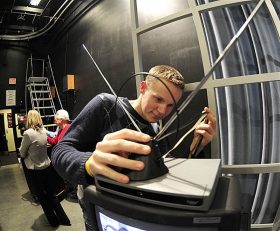North Carolina television viewers flooded the School of Communications with phone calls Thursday as Elon students manned a call center to answer questions about a nationwide conversion to digital television. Regional stations alerted viewers to the DTV change on Feb. 17, 2009, with two “soft tests” that interrupted regular programming for people who rely on antennas to get reception.


In both instances, stations interrupted programs with a message that told viewers about the change. For people who rely on over-the-air service but who lack a DTV converter box, the message was simple: On February 17, you will no longer be able to receive television signals.
Students were able to answer questions or solve problems experienced by 90 percent of callers.
The test was coordinated by the North Carolina Association of Broadcasters, which, until now, had been conducting similar tests on the 17th of every month since September. It is the final test scheduled before Feb. 17.
Viewers with converters, or those who subscribe to cable or satellite providers, were largely unaffected by the test. A handful of callers reported losing a signal despite their purchase of a converter box or their subscription to cable or satellite.
“People are still working out the kinks with the strength that they need on their antenna and whether that antenna needs to be mounted on a roof or in an attic versus rabbit ears,” said Connie Book, associate dean of the School of Communications who has researched digital television for the past decade. “But the main issue is satellite and cable companies have not fully finished integrating digital signals into their services, so people are confused thinking they’re ready and then they see that analog warning.”
The information students collected between 6 and 9:30 p.m. revealed common traits among viewers currently unprepared for the switch. Callers tended to be over 50 and sought information on obtaining a coupon from the federal government to help with the purchase of a digital converter box.
Some calls were handled within seconds. Students easily directed viewers to locations for obtaining a converter box or a coupon. Other calls took several minutes, notably from viewers who reported technical problems with equipment they had already purchased.
“A lot of people think that just because they have a digital TV they don’t need their antenna any more. That’s not true,” said Maura McGrath, a senior broadcast communications major from Massachusetts. “They still need the antenna to get the signal – it’s just digital, not analog. It’s like a cell phone. If you don’t have an antennae on your cell phone that doesn’t mean you’ll get the call.”
Not all callers were pleasant, though they were in the minority, McGrath said.
“We’ve had a few angry people, a few hang ups, a little yelling,” she said. “But most people are nice and appreciate the help.”
Students will return to the call center on February 17 to again answer questions and provide help to callers when the nationwide switch takes place, assuming Congress makes no move to delay the digital switch. President-elect Barack Obama has called on lawmakers to postpone the transition due to a lack of coupons available for Americans who call the FCC for a voucher to buy the converter boxes.


